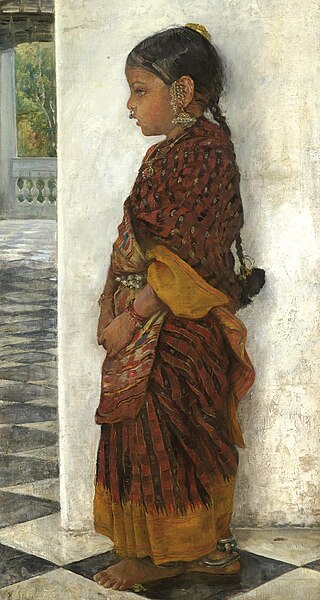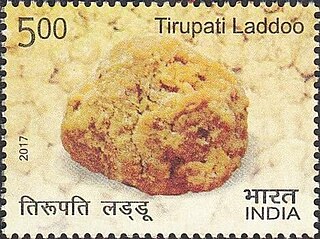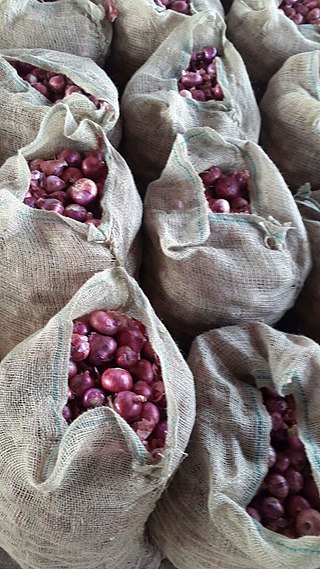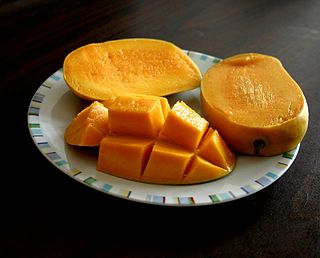Related Research Articles

Ooty, abbreviated as Udhagai) is a town and municipality in the Nilgiris district of the Indian state of Tamil Nadu. It is located 86 km (53 mi) northwest of Coimbatore, and is the headquarters of Nilgiris district. Situated in the Nilgiri hills, it is known by the epithet "Queen of Hill Stations", and is a popular tourist destination.

Haleem is a type of stew that is widely consumed in South Asia, the Middle East and Central Asia. Although the dish varies from region to region, it optionally includes wheat or barley, meat and lentils. It is made by blending or mashing the meat in the curry and serving hot with flat breads or on its own. The original Haleem, which is different from this variety, is an ancient Iranian dish served with wheat, meat, cinnamon, and sugar that remains popular in Iran. Popular variations of haleem include keşkek in Turkey, Tajikistan, Uzbekistan, Azerbaijan and northern Iraq; harisa in the Arab world and Armenia; halim in Afghanistan, Iran, West Bengal, in Mauritius and Bangladesh; and khichra in Pakistan and India.

A geographical indication (GI) is a name or sign used on products which corresponds to a specific geographical location or origin. The use of a geographical indication, as an indication of the product's source, is intended as a certification that the product possesses certain qualities, is made according to traditional methods, or enjoys a good reputation due to its geographical origin.

Rasgulla is a syrupy dessert popular in the eastern part of South Asia. It is made from ball-shaped dumplings of chhena dough, cooked in light sugar syrup. This is done until the syrup permeates the dumplings.

Madhubani art is a style of painting practiced in the Mithila region of India and Nepal. It is named after the Madhubani district of Bihar, India, which is where it originated. Jitwarpur and Ranti are the two most notable cities associated with the tradition and evolution of Madhubani art. The art was traditionally practiced by female members of Brahman and Kayastha castes. Artists create these paintings using a variety of mediums, including their own fingers, or twigs, brushes, nib-pens, and matchsticks. The paint is created using natural dyes and pigments. The paintings are characterized by their eye-catching geometrical patterns. There is ritual content for particular occasions, such as birth or marriage, and festivals, such as Holi, Surya Shasti, Kali Puja, Upanayana, and Durga Puja.

Banganapalle mangoes is a mango variety produced in Banganapalle of Nandyal District in the Indian state of Andhra Pradesh. It alone occupies 70% percent of total mango cultivable area of the state and was first introduced by the farmers of Banaganapalli. It was registered as one of the geographical indication from Andhra Pradesh on 3 May 2017, under horticultural products by Geographical Indication Registry. It is also grown in the other parts of India and Pakistan. The fruit is described as obliquely oval in shape, around 20cm in length, with yellow flesh and a thin, smooth yellow skin. The flesh is of a firm, meaty texture and is sweet and lacks fibre. The cultivar is the most sought after in Andhra Pradesh. It is a very late-season variety that is good for canning. This cultivar is a source of vitamin A & C and is also called king of Mangoes.

Kolhapuri chappals are Indian decorative hand-crafted and braided leather slippers that are locally tanned using vegetable dyes. Kolhapuri Chappals or Kolhapuris as they are commonly referred to are a style of open-toed, T-strap sandal, but also braided leather Mules or braided leather shoe type designs are also common.

Bikaneri bhujia, often simply called bhujia, is a crispy snack prepared by using vigna aconitifolia, gram flour and spices, originating from Bikaner, a city in the western state of Rajasthan in India. It is light yellow in colour. Bhujia has become not just a characteristic product of Bikaner, but also a generic name.

The Kanchipuram silk sari is a type of silk sari made in the Kanchipuram region in Tamil Nadu, India. These saris are worn as bridal & special occasion saris by most women in Tamil Nadu, Kerala, Karnataka & Andhra Pradesh. It has been recognized as a Geographical indication by the Government of India in 2005–2006.

Pochampally sari or Pochampalli ikat is a saree made in Bhoodan Pochampally, Yadadri Bhuvanagiri district, Telangana State, India. They have traditional geometric patterns in "Paagadu Bandhu" (Ikat) style of dyeing. The intricate geometric designs find their way into sarees and dress materials. The Indian government's official airplane company, Air India, has its cabin crew wear specially designed Pochampally silk sarees.
Kovai Cora cotton or Kovai Kora cotton is a type of cotton saree made in the Coimbatore region in Tamil Nadu, India. It has been recognized as a Geographical indication by the Government of India in 2014–15.
The Geographical Indications of Goods Act, 1999 is a sui generis Act of the Parliament of India for protection of geographical indications in India. India, as a member of the World Trade Organization (WTO), enacted the Act to comply with the Agreement on Trade-Related Aspects of Intellectual Property Rights. The GI tag ensures that only those registered as authorised users are allowed to use the popular product name. Darjeeling tea became the first GI tagged product in India, in 2004–05, since then 370 goods had been added to the list as of August 2020.
Muttathu Varkey Award for contributions to the field of Malayalam literature is instituted by the Muttattu Varkey Foundation in memory of novelist Muttathu Varkey. The award was instituted in 1992 and as of 2012, it carries a purse of ₹50000, a citation, and a statuette. The awards are usually announced on 28 April and presented on 28 May every year.

Tirupati Laddu or SriVari Laddu is the laddu sweet offered as Naivedhyam to Venkateswara at Tirumala Venkateswara Temple in Tirupati, Tirupati district, Andhra Pradesh, India. The laddu is given as prasadam to devotees after having the darshan in the temple. The laddu prasadam is prepared within the temple kitchen known as 'Potu' by the temple board Tirumala Tirupati Devasthanams. Tirupati Laddu received Geographical indication tag which entitles that only Tirumala Tirupati Devasthanams can make and sell it.

Bangalore rose onion, locally called gulabi eerulli, is a variety of onion grown in and around Bangalore in Karnataka. It received the Geographical Indication tag in 2015.

Kangra tea is a tea from the Kangra district in Himachal Pradesh, India. Both black tea and green tea have been produced in the Kangra Valley since the mid-19th century. Kangra tea was given the Geographical Indication status in 2005.

Mahabaleshwar strawberry is a strawberry grown in the hilly slopes of Mahabaleshwar, which accounts for about 85 percent of the total strawberry produced in India. Strawberry, along with raspberry, mulberry and gooseberry, is produced on a large scale in and around Mahabaleshwar. Mahabaleshwar strawberry obtained the geographical indication (GI) tag in 2010.

The 'Gir Kesar' mango, also called Kesar, is a mango cultivar grown in the foothills of Girnar in Gujarat, western India. The mango is known for its bright orange colored pulp and was given the geographical indication status in 2011. The biggest market of Gir Kesar is in Talala Gir known as a Mango Market Yard.

Kandangi is a type of cotton saree from the Chettinad region of the Indian state of Tamil Nadu. It was declared as a Geographical indication in 2019–20.
References
- ↑ "'Ooty varkey' synonymous with the Blue Mountains". The Hindu . 7 December 2014. Retrieved 11 December 2017.
- ↑ Nainar, Nahla (17 August 2018). "The journey of the famous Ooty 'varkey'". The Hindu . ISSN 0971-751X . Retrieved 30 March 2020.
- ↑ The Hindu, Cities, Coimbatore (2 October 2015). "'No animal fat in Ooty varkey'". The Hindu . Retrieved 11 December 2017.
{{cite news}}: CS1 maint: multiple names: authors list (link) - ↑ M.Soundariya Preetha (27 July 2015). "Efforts on to get GI recognition for Ooty 'Varkey'". The Hindu . Retrieved 11 December 2017.
- ↑ Geographical indications in India (Report). Government of India . Retrieved 1 December 2023.
